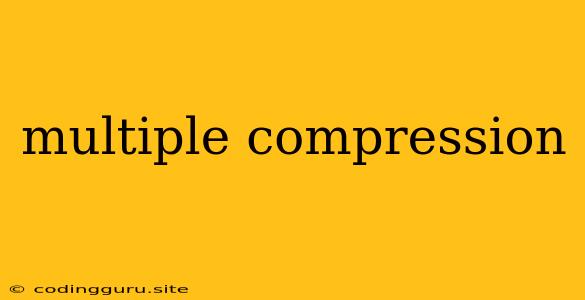The Art of Multiple Compression: Enhancing Efficiency and Reducing Storage
In the digital age, data is king. With ever-increasing amounts of information being generated, storage space and bandwidth are becoming increasingly precious commodities. This has led to a growing demand for efficient data compression techniques to minimize storage requirements and optimize transmission speeds. While single compression algorithms are effective, multiple compression offers a powerful approach to further enhance efficiency and reduce storage footprint.
What is Multiple Compression?
Multiple compression, also known as multi-level compression or stacked compression, refers to applying multiple compression algorithms sequentially to a single dataset. Each algorithm targets specific data characteristics, aiming to further reduce redundancy and optimize the compressed representation.
Why Choose Multiple Compression?
Here are some key advantages of multiple compression that make it a compelling choice for data optimization:
- Enhanced Compression Ratio: By combining the strengths of different algorithms, multiple compression can achieve significantly higher compression ratios compared to single-level compression. This translates to smaller file sizes and reduced storage needs.
- Improved Data Integrity: Some algorithms excel in removing specific types of redundancy. Combining them allows for targeted compression, minimizing the risk of information loss or distortion.
- Flexibility and Adaptability: Multiple compression offers flexibility in choosing the optimal combination of algorithms for different data types and compression goals. This allows for tailored solutions to specific requirements.
Common Multiple Compression Techniques
Several popular techniques are used for multiple compression, each with its own strengths and applications:
- Lossless Compression: Lossless algorithms like gzip and bzip2 are often used as the first stage of multiple compression. They eliminate redundancy without any data loss, providing a strong foundation for further optimization.
- Lossy Compression: Algorithms like JPEG and MPEG are used in the second stage to further reduce file sizes by selectively discarding less important data. This technique is typically applied to image and video data where some loss can be tolerated for significant size reduction.
- Dictionary-based Compression: Algorithms like LZMA and LZ77 utilize dictionaries to replace recurring patterns with shorter codes, further compressing the data. These techniques are often used in conjunction with other compression methods.
Examples of Multiple Compression in Action:
- Image Optimization: Websites often use multiple compression techniques to optimize images for faster loading times. First, a lossless algorithm like PNG is used to minimize file size while preserving image quality. Then, a lossy algorithm like JPEG is applied to further reduce file size, albeit with a slight reduction in image quality.
- Video Streaming: Video streaming platforms like Netflix and YouTube employ multi-level compression to ensure smooth playback across different devices and internet speeds. Video data is first compressed using lossy algorithms, and then additional compression techniques are applied to further reduce file size and bandwidth requirements.
Challenges and Considerations:
While multiple compression offers significant benefits, it's important to be aware of the following:
- Computational Overhead: Applying multiple compression algorithms can increase processing time, potentially impacting performance, especially for real-time applications.
- Algorithm Compatibility: Not all compression algorithms work well together. Careful selection and optimization are crucial to ensure efficient and effective compression.
- Decoding Complexity: Decompressing multi-compressed data requires multiple steps, which can increase decoding time and complexity.
Conclusion:
Multiple compression is a powerful technique that can dramatically enhance data compression efficiency and reduce storage requirements. By combining the strengths of different algorithms, it allows for targeted optimization and improved data integrity. While there are challenges to consider, the advantages of multiple compression outweigh the drawbacks in many applications, making it an invaluable tool for managing and optimizing large datasets in today's data-driven world.
